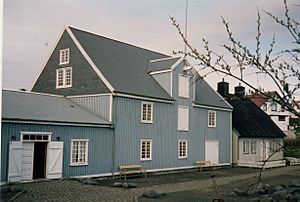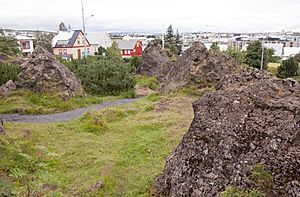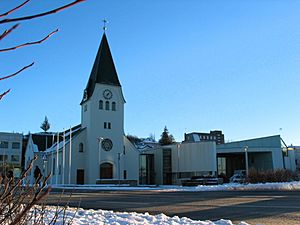Hafnarfjörður facts for kids
Quick facts for kids
Hafnarfjörður
|
||
|---|---|---|
|
Municipality
|
||
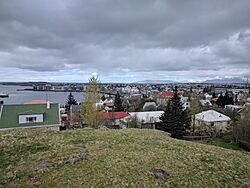
May 2017 view over Hafnarfjörður's town centre
|
||
|
||
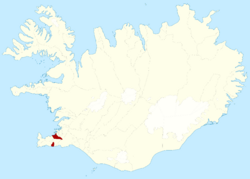
Location of the municipality
|
||
| Country | Iceland | |
| Region | Capital Region | |
| Constituency | Southwest Constituency | |
| Area | ||
| • Total | 143 km2 (55 sq mi) | |
| Population
(2020)
|
||
| • Total | 29,971 | |
| • Density | 208.38/km2 (539.7/sq mi) | |
| Postal code(s) |
220, 221, 222
|
|
| Municipal number | 1400 | |
Hafnarfjörður (say it like: HAP-nar-fyur-thur) is a busy port town in Iceland. It's located about 10 kilometers (6 miles) south of Reykjavík, the capital city. Hafnarfjörður is the third-largest town in Iceland, with around 30,000 people living there. It's known for its local businesses, fun activities, and yearly festivals.
Contents
Fun Things to Do in Hafnarfjörður
The town offers many exciting things to see and do.
Viking Festival Fun
Every June, Hafnarfjörður hosts a famous Viking festival. People who love Viking culture come from all over the world. They show off reconstructed Viking clothes, amazing handmade crafts, and even demonstrate sword-fighting and longbow shooting. It's like stepping back in time!
Local Industries and Economy
Hafnarfjörður has a strong local economy, especially linked to its harbor.
Aluminium Smelter Operations
Just outside Hafnarfjörður, there's a large aluminium smelter. This factory is run by a company called Alcan. It was first built in 1969. In 2007, the people of Hafnarfjörður voted against making the smelter bigger.
History of Hafnarfjörður
Hafnarfjörður has a long and interesting history, especially because of its natural harbor.
| 1910 | 1,547 |
|---|---|
| 1920 | 2,366 |
| 1930 | 3,591 |
| 1940 | 3,686 |
| 1950 | 5,087 |
| 1960 | 7,160 |
| 1970 | 9,696 |
| 1980 | 12,205 |
| 1990 | 15,151 |
| 2000 | 19,640 |
| 2010 | 25,913 |
| 2015 | 28,200 |
| 2020 | 29,971 |
How the Town Got Its Name
The name Hafnarfjörður means "harbor fjord". It comes from the town's excellent natural harbor. The town is built on old lava fields from the nearby Krýsuvík volcano. The last time lava flowed here was before Iceland was settled, but the Krýsuvík system is still an active volcano.
Early Trading Days
Hafnarfjörður is mentioned in old Icelandic books from the Middle Ages. People started sailing to Hafnarfjörður to trade goods in the late 1300s. English traders came first in the 1400s, but German merchants soon followed. The German traders eventually took over. Hafnarfjörður became an official member of the Hanseatic League, which was a powerful group of trading cities.
The first Lutheran church in Iceland was built near Hafnarfjörður in 1533. German traders stayed in town until 1602. After that, the Danish king took control of all trade in Iceland. This Danish trade rule lasted until the late 1700s. During this time, Hafnarfjörður was Iceland's busiest trading center.
Growth and Modernization
In 1793, a man named Bjarni Sívertsen moved to Hafnarfjörður. He became very important in local business and international trade. He started a big commercial fishing company. His hard work helped the town's trade grow a lot. People called him "the father of Hafnarfjörður" or "Sir Bjarni." His old house, built in 1803, is now a museum.
Around 1870, fishing in Iceland changed a lot. People started using bigger, decked boats instead of small row-boats. This created more jobs and helped Hafnarfjörður grow quickly. In 1908, Hafnarfjörður became an official municipality (a self-governing town). It was the fifth town in Iceland to get this status. The first mayor was Páll Einarsson, who later became the mayor of Reykjavík.
The first road between Reykjavík and Hafnarfjörður was finished in 1898. Iceland's first power plant that used water to make electricity was built in Hafnarfjörður in 1904.
In 1890, Hafnarfjörður had 616 people, making it one of Iceland's largest towns. By 1908, when it became a municipality, it had 1,400 people. The population continued to grow steadily over the years.
Fishing and Shipping Hub
The Coot, Iceland's first trawler (a type of fishing boat), worked from Hafnarfjörður between 1905 and 1908. You can still see its old boiler near a roundabout in town. A harbor for large ships was built in 1912. The first car arrived in Hafnarfjörður in 1913.
After World War II, more modern fishing boats were added to the fleet. Today, Hafnarfjörður is one of Iceland's biggest fishing centers. It also has Iceland's first auction market for fish. Fishing has always been important, but recently, moving goods by ship has become the main activity at the harbor. Hafnarfjörður is now Iceland's second-biggest harbor for importing and exporting goods.
Geography and Climate
Hafnarfjörður is located on the southwest coast of Iceland.
Hafnarfjörður Climate
The climate in Hafnarfjörður is a subpolar oceanic climate. This means it has cool summers and mild winters, with rain or snow throughout the year.
| Climate data for Hafnarfjörður (1991-2020, extremes 1951-present) | |||||||||||||
|---|---|---|---|---|---|---|---|---|---|---|---|---|---|
| Month | Jan | Feb | Mar | Apr | May | Jun | Jul | Aug | Sep | Oct | Nov | Dec | Year |
| Record high °C (°F) | 15.9 (60.6) |
12.5 (54.5) |
16.0 (60.8) |
17.0 (62.6) |
21.4 (70.5) |
23.7 (74.7) |
23.8 (74.8) |
24.5 (76.1) |
19.7 (67.5) |
14.5 (58.1) |
16.0 (60.8) |
12.9 (55.2) |
24.5 (76.1) |
| Mean daily maximum °C (°F) | 3.5 (38.3) |
3.6 (38.5) |
4.5 (40.1) |
6.8 (44.2) |
9.6 (49.3) |
12.2 (54.0) |
13.7 (56.7) |
13.5 (56.3) |
11.2 (52.2) |
7.6 (45.7) |
4.9 (40.8) |
3.5 (38.3) |
7.9 (46.2) |
| Daily mean °C (°F) | 1.2 (34.2) |
1.2 (34.2) |
1.9 (35.4) |
4.2 (39.6) |
7.0 (44.6) |
9.7 (49.5) |
11.3 (52.3) |
11.1 (52.0) |
8.8 (47.8) |
5.4 (41.7) |
2.7 (36.9) |
1.1 (34.0) |
5.5 (41.9) |
| Mean daily minimum °C (°F) | −1.2 (29.8) |
−1.2 (29.8) |
−0.6 (30.9) |
1.5 (34.7) |
4.3 (39.7) |
7.1 (44.8) |
8.8 (47.8) |
8.6 (47.5) |
6.3 (43.3) |
3.1 (37.6) |
0.4 (32.7) |
−1.3 (29.7) |
3.0 (37.4) |
| Record low °C (°F) | −15.3 (4.5) |
−12.2 (10.0) |
−18 (0) |
−10 (14) |
−6 (21) |
−1 (30) |
1.9 (35.4) |
1.4 (34.5) |
−5.5 (22.1) |
−7.2 (19.0) |
−10.7 (12.7) |
−17 (1) |
−18 (0) |
| Average precipitation mm (inches) | 141.7 (5.58) |
136.4 (5.37) |
119.9 (4.72) |
77.6 (3.06) |
77.4 (3.05) |
72.1 (2.84) |
77.1 (3.04) |
112.3 (4.42) |
122.6 (4.83) |
159.9 (6.30) |
121.3 (4.78) |
143.6 (5.65) |
1,361.9 (53.64) |
| Source: Météo Climat (precipitation 1981-2010) | |||||||||||||
Local Festivals and Events
Hafnarfjörður hosts a couple of fun festivals each year.
Bright Days Festival
Every May, the Bright Days festival takes place. It includes short movies and concerts. The festival usually ends with a day to honor Iceland's sailors.
Viking Festival Celebration
As mentioned before, a Viking festival is held every year on the summer solstice. A local pub and restaurant, Fjörukráin, started this festival and still runs it today.
Places to See in Hafnarfjörður
Hafnarfjörður has many interesting old buildings and unique sights.
Historic Buildings and Museums
You can find many old buildings in the town center. Pakkhúsið is a storehouse from 1865 that now holds the Museum of Navigation. Sívertsenshús, built in 1803, is the oldest house in Hafnarfjörður. It's also a museum.
Hafnarfjarðarkirkja is the oldest church in town, opened in 1914. The streets Strandgata and Fjarðargata have many preserved historic buildings. For example, a wooden storehouse from 1841 is at No. 55 Strandargata.
Churches and Religious Sites
St. Joseph's Church (Sankti Jósefskirkja) is one of the few Roman Catholic churches in Iceland. Its community started in 1926. Karmelklaustur is the only Catholic monastery in Iceland. Fríkirkjan í Hafnarfirði is a Protestant church built in 1913.
Arts, Culture, and Nature
Hafnarborg is a center for arts and culture where you can enjoy concerts and exhibitions. Hafnarfjörður also has its own Municipal Theatre. You can visit the Icelandic Museum of Films and a Museum of Telecommunication.
Many Icelanders believe in elves and trolls. Hellisgerði is a small park with lava rocks in the town center. Many people believe elves and trolls live there. This park also has the world's northernmost Bonsai trees!
Víðistaðatún is another park in the town center. It's famous for its sculptures made by Icelandic and international artists. Víðistaðakirkja is a modern, curved church opened in this park in 1988. The symbol of Hafnarfjörður is Viti, a lighthouse built around 1900. You can see it in a residential area.
Swimming Pools in Hafnarfjörður
Hafnarfjörður has three swimming pools for everyone to enjoy: Suðurbæjarlaug, Ásvallalaug, and Sundhöll Hafnarfjarðar.
Twin Towns and Sister Cities
Hafnarfjörður is connected with other towns around the world as twin towns. This helps them share culture and ideas.
Sports in Hafnarfjörður
Hafnarfjörður is home to two main sports clubs: Fimleikafélag Hafnarfjarðar (FH) and Knattspyrnufélagið Haukar.
Football and Handball Achievements
FH's men's and women's football teams have won many national championships. FH is also very successful in Icelandic handball, having won the league 25 times and the cup 6 times. This makes them the most successful handball team in Iceland.
Haukar also has a great history in handball, winning many titles. They were champions in 1943, 2000, 2001, 2003, 2004, 2005, 2008, 2009, 2010, and 2015. They also won the cup in 1980, 1997, 2001, 2002, and 2010.
Other Sports Clubs
Hafnarfjörður also has a gymnastics club called Fimleikafélagið Björk, started in 1951. The local swimming club, Sundfélag Hafnarfjarðar (SH), was founded in 1945. A triathlon club, 3SH, is part of the swimming club.
Keilir Golf Club is an 18-hole golf course located on the Hvaleyri peninsula.
World's Northernmost Cricket Field
In 2019, Iceland Cricket opened the world's northernmost cricket field in Hafnarfjörður. This field is located at 64.07°N latitude. It broke the previous record held by a field in Umeå, Sweden. The Prime Minister of Iceland, Katrín Jakobsdóttir, officially opened the field.
Famous People from Hafnarfjörður
Many talented people have come from Hafnarfjörður:
- Ólafía Einarsdóttir, the first Icelander to get a degree in archaeology.
- Elin Sigurdardottir, an Olympic swimmer who competed twice.
- Logi Geirsson, a former handball player.
- Ragnheiður Gestsdóttir, a writer of children's books.
- Friðrik Dór Jónsson, a pop artist.
- Jón Jónsson, another pop artist.
- Ólafur Guðmundsson, a handball player.
- Hildur Guðnadóttir, an Academy Award-winning composer.
- Björgvin Halldórsson, a musician.
- Emil Hallfreðsson, a former football player.
- Geir Hallsteinsson, a former handball player.
- The indie band Jakobínarína.
- Jóhanna Guðrún Jónsdóttir (Yohanna) grew up in Hafnarfjörður. She represented Iceland in the Eurovision Song Contest 2009 and came in 2nd place.
- Aron Pálmarsson, a handball player for THW Kiel.
- Gylfi Sigurðsson, a football player who currently plays for Danish Superliga club Lyngby.
- Sóley (musician), an indie pop singer-songwriter.
- Stefán Karl Stefánsson, an actor famous for playing Robbie Rotten in the children's TV show LazyTown.
- Þórhallur Sigurðsson, known as Laddi, an actor.
- Dagur Dan Þórhallsson, a football player.
See also
 In Spanish: Hafnarfjörður para niños
In Spanish: Hafnarfjörður para niños



